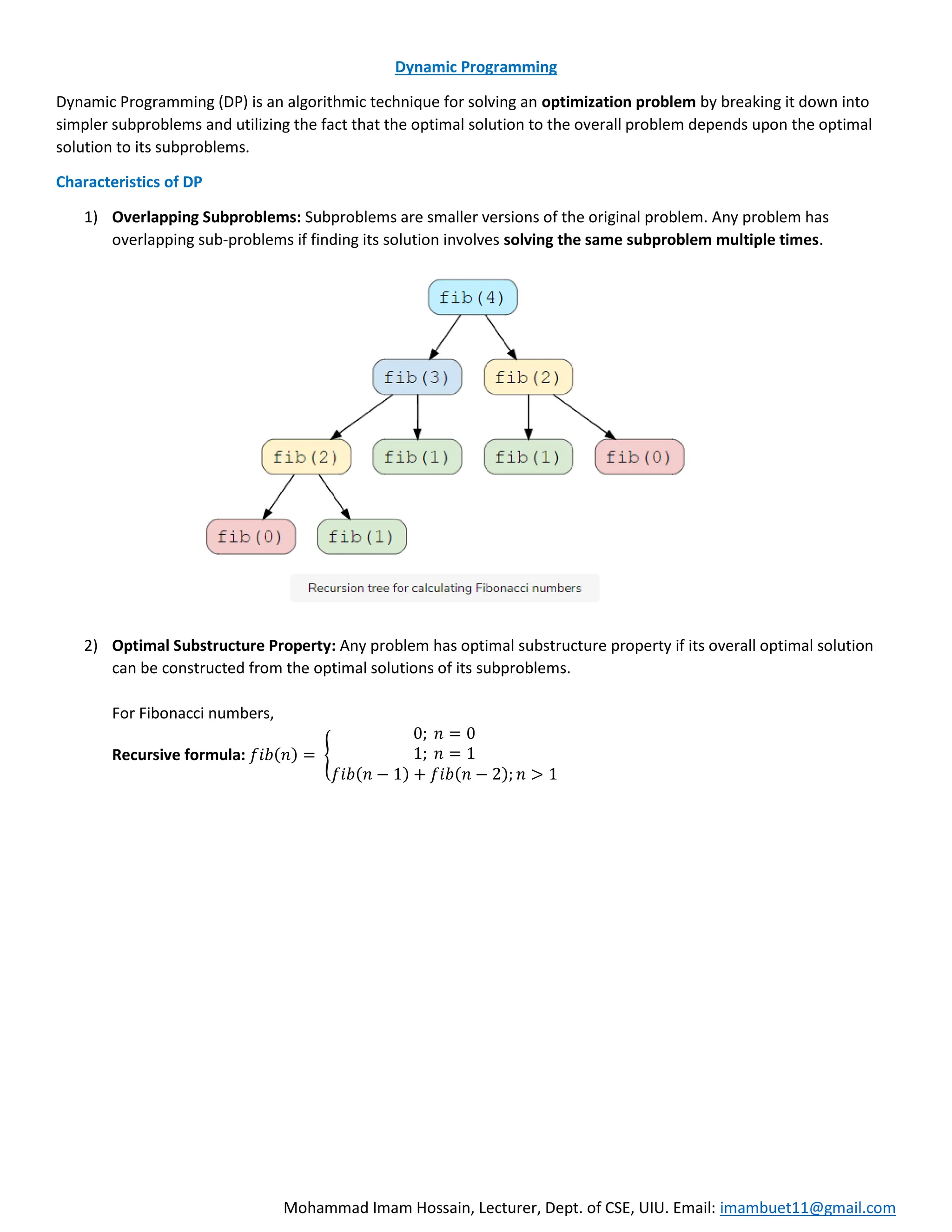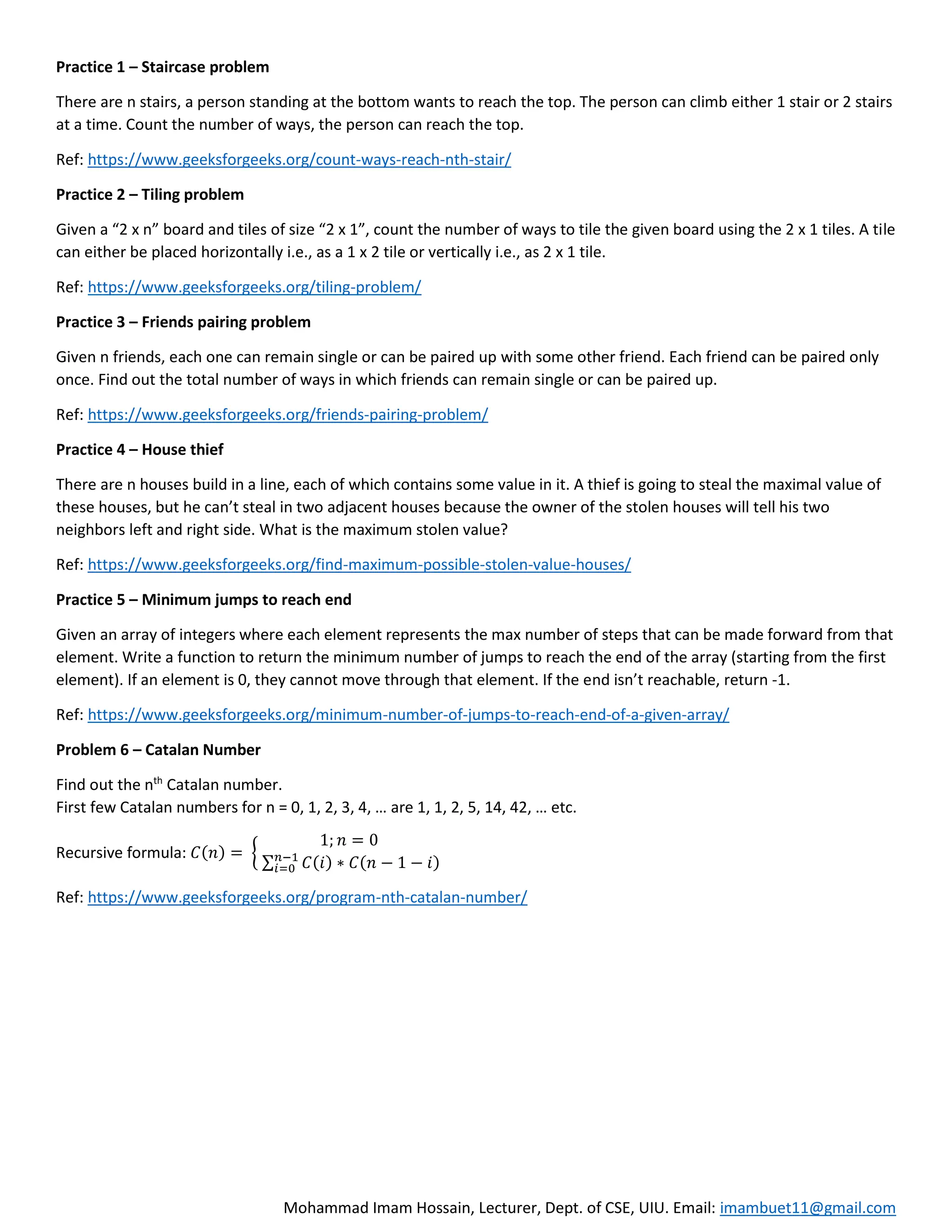The document discusses dynamic programming and provides examples of problems that can be solved using dynamic programming techniques. It describes characteristics of dynamic programming problems such as overlapping subproblems and optimal substructure properties. It also describes two common approaches to dynamic programming - top-down with memorization and bottom-up with tabulation. Finally, it lists 12 practice problems related to topics like staircase problem, tiling problem, friends pairing problem, house thief problem, minimum jumps problem, Catalan numbers, binomial coefficients, permutation coefficients, subset sum problem, 0/1 knapsack problem, longest common subsequence and edit distance that can be solved using dynamic programming.

![Mohammad Imam Hossain, Lecturer, Dept. of CSE, UIU. Email: imambuet11@gmail.com
DP Methods
1) Top-down with Memorization: In this approach, we try to solve the bigger problem by recursively finding the
solution to smaller sub-problems. Whenever we solve a sub-problem, we cache its result so that we don’t end
up solving it repeatedly if it’s called multiple times. Instead, we can just return the saved result. This technique
of storing the results of already solved subproblems is called Memorization.
Recursive Implementation Top-down with Memorization
int fib(int term){
if(term==0){
return 0; ///base condition 1
}
else if(term==1){
return 1; ///base condition 2
}
else{
///recursive subproblems
int myresult=fib(term-1)
+fib(term-2);
return myresult;
}
}
int cache[100]={0};
int memfib(int term){
if(term==0){
return 0; ///base condition 1
}
else if(term==1){
return 1; ///base condition 1
}
else{
///checking the cache memory
if(cache[term]!=0){
///found
return cache[term];
}
else{
///not found
cache[term]=memfib(term-1)
+memfib(term-2);
return cache[term];
}
}
}
2) Bottom-up with Tabulation: Tabulation is the opposite of the top-down approach and avoids recursion. In this
approach, we solve the problem “bottom-up” (i.e. by solving all the related sub-problems first). This is typically
done by filling up an n-dimensional table. Based on the results in the table, the solution to the top/original
problem is then computed.
Recursive Implementation Bottom-up with Tabulation
int fib(int term){
if(term==0){
return 0; ///base condition 1
}
else if(term==1){
return 1; ///base condition 2
}
else{
///recursive subproblems
int myresult=fib(term-1)
+fib(term-2);
return myresult;
}
}
int dptable[100];
int dpfib(int term){
dptable[0]=0; ///base condition 1
dptable[1]=1; ///base condition 2
///filling up the table
for(int t=2;t<=term;t++){
dptable[t]=dptable[t-1]+dptable[t-2];
}
return dptable[term];
}](https://image.slidesharecdn.com/dynamicprogramming-231010161014-53a96a78/75/DS-Algo-6-Dynamic-Programming-2-2048.jpg)

![Mohammad Imam Hossain, Lecturer, Dept. of CSE, UIU. Email: imambuet11@gmail.com
Practice 7 – Binomial coefficient
Write a function that takes two parameters n, r and returns the value of Binomial Coefficient C(n, r) or, nCr.
Ref: https://www.geeksforgeeks.org/binomial-coefficient-dp-9/
Practice 8 – Permutation coefficient
Write a function that takes two parameters n, r and returns the value of nPr.
Ref: https://www.geeksforgeeks.org/permutation-coefficient/
Practice 9 – Subset sum
Given a set of non-negative integers, and a value sum, determine if there is a subset of the given set with sum equal to
given sum.
Ref: https://www.geeksforgeeks.org/subset-sum-problem-dp-25/
Practice 10 – 0/1 Knapsack problem
Given weights and values of n items, put these items in a knapsack of capacity W to get the maximum total value in the
knapsack. In other words, given two integer arrays val[0..n-1] and wt[0..n-1] which represent values and weights
associated with n items respectively. Also given an integer W which represents knapsack capacity, find out the maximum
value subset of val[] such that sum of the weights of this subset is smaller than or equal to W. You cannot break an item,
either pick the complete item or don’t pick it (0-1 property).
Ref: https://www.geeksforgeeks.org/0-1-knapsack-problem-dp-10/
Practice 11 – Longest Common Subsequence
Given two sequences, find the length of longest subsequence present in both of them. A subsequence is a sequence that
appears in the same relative order, but not necessarily contiguous. For example, “abc”, “abg”, “bdf”, “aeg”, ‘”acefg”, ..
etc are subsequences of “abcdefg”.
Ref: https://www.geeksforgeeks.org/longest-common-subsequence-dp-4/
Practice 12 – Edit Distance
Given two strings str1 and str2 and 3 operations (Insert, Replace, Delete) that can be performed on str1. Find minimum
number of edits (operations) required to convert ‘str1’ into ‘str2’. All of the above operations are of equal cost.
Ref: https://www.geeksforgeeks.org/edit-distance-dp-5/](https://image.slidesharecdn.com/dynamicprogramming-231010161014-53a96a78/75/DS-Algo-6-Dynamic-Programming-4-2048.jpg)